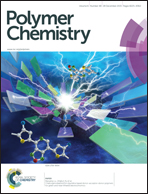Switchable glucose-responsive volume phase transition behavior of poly(phenylboronic acid) microgels†
Abstract
We develop a class of poly(phenylboronic acid) microgels, which are made of 3-aminophenylboronic acid covalently bonded to oligo(ethylene glycol)-based polymers, to demonstrate the feasibility of on-site tailoring of the glucose-responsive volume phase transition behavior of poly(phenylboronic acid) gels. Different from the poly(phenylboronic acid) gels reported previously that typically undergo a fixed type (swelling and/or shrinking) of glucose-responsive volume phase transition behavior, the presented microgels can display switchable behavior upon adding glucose: shrinking (at temperature ≤29.0 °C), unresponsive (29.0–33.0 °C), and swelling (≥33.0 °C). The underlying mechanism for such an on-site tailoring is possibly associated with a competition of glucose-induced increase in the Donnan potential (favoring swelling; due to the formation of glucose-boronates or glucose-bis-boronates) and additional cross-links (favoring shrinking; due to the formation of glucose-bis-boronates) at a particular temperature. Accompanied by this on-site tailoring, the photoluminescence of the microgels can be tuned from “turn-off” (e.g., at 25.0 °C) to “turn-on” (e.g., at 37.0 °C) upon adding glucose, which may provide a functional basis for biosensors for prospective biomedical applications.


 Please wait while we load your content...
Please wait while we load your content...